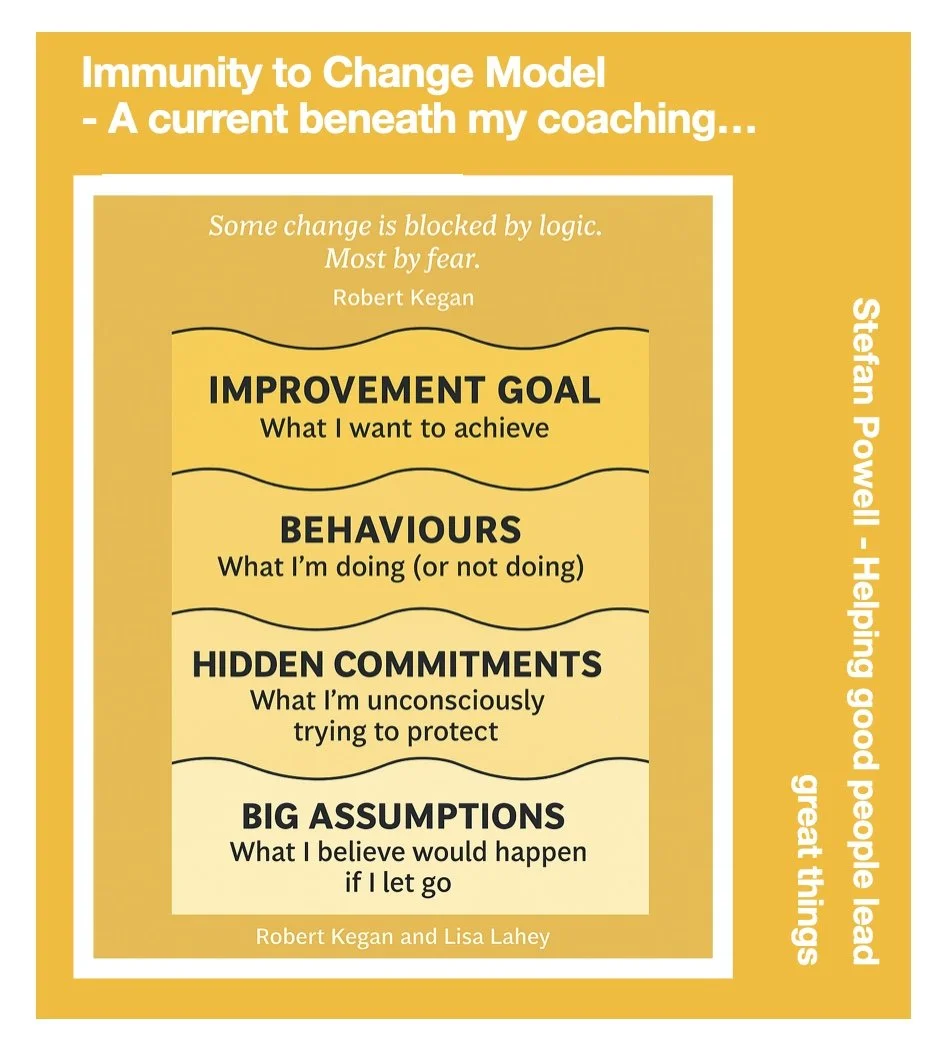Week 1– The Immunity to Change Model
The Currents Beneath My Coaching: Week One – Immunity to Change Model
Over the years I’ve coached, led and developed thousands of leaders. My work is grounded in real conversations, behavioural change and performance psychology born from practice, not theory. I’ve read hundreds of books. Interrogated so many models – but I rarely talk about them. Behind the questions I ask and the shifts I help create, there’s a body of knowledge that’s shaped my approach, and theories I haven’t committed to memory but which inform how I work.
This series is my way of surfacing that – one model at a time.
These models are the currents beneath the waves of my coaching – the quiet but powerful forces that shape each leadership journey I walk alongside.
Let’s begin with one that helps articulate resistance – Immunity to Change by Robert Kegan and Lisa Lahey.
Why we say we want change – but don’t
You commit to something that matters – being clearer, calmer, more focused.
And yet… something pulls you back.
Kegan and Lahey call this the immunity to change.
They suggest we often hold hidden commitments – deep, self-protective beliefs that quietly work against our goals.
Not because we’re lazy.
But because part of us is trying to keep us safe.
Their model reveals four layers:
A meaningful improvement goal
The behaviours working against it
Hidden competing commitments
The big assumptions holding those in place
It’s like uncovering the root system under the surface.
Once it’s named, it can begin to shift.
Why I use it
I’ve never shared the map directly. But I weave its underpinnings into my questions when the time and context are right.
It helps me ask better questions.
It helps leaders name what’s unspoken.
It brings clarity to the gap between what they want and what they’re doing.
When people feel stuck, this model offers language, structure and compassion.
Coaching Example
In one coaching session, a senior leader came in frustrated about their inability to delegate. They said they wanted to empower their team more, but kept taking work back. As we explored it, it became clear this wasn’t about workload—it was about trust. Beneath the surface was a hidden commitment to keeping control, rooted in an assumption that trusting others would lead to mistakes they’d ultimately be responsible for. Naming that changed everything. It gave them space to experiment with clearer boundaries, shared ownership and a new kind of leadership presence.
Your reflection for the week:
Where do you keep hitting the same wall?
What fear – or old belief – might be holding it in place?
This series shares the models that quietly shape how I coach. I hope it’s useful. And if it lands – let’s talk.
—Stefan
‘Enjoyed’ reading this? Consider doing one of these:
Sign up to my newsletter ‘Be The Waves” here - which collates each weeks long form post on a monthly basis and you’ll get to read it later in the month
Get in touch - If any of this topic resonated with you and you have something you’d like to share with me or if you’d like to discuss working with me on this topic - stefan@stefanpowell.co.uk works really well for me.
Connect with me on linked in and read my long form posts on the rotating topics of Work, Rest. Play, Sustenance and Love every Thursday
Book an inquisitive session with me to find out more about what I do and how I do it or run a challenge or thought you have passed me.
I look forward to sharing my next OPINION blog soon.
For now; thank you
I am…
An executive coach who specialises in helping good people lead great things.
Good people care about others, our planet and beauty. Great things are changes for the betterment of society and all that lives within an around it.
It sounds big and fun - it is.
I'm also an endurance racing cyclist and a go. getter.
You can read more about me and what I do; how I work here

